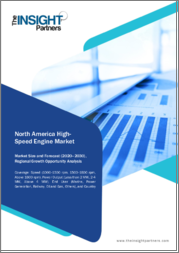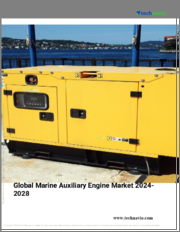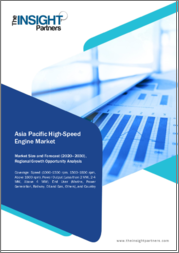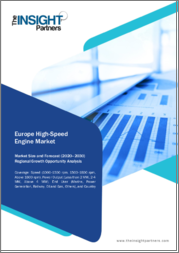
|
시장보고서
상품코드
1535640
선박용 왕복 엔진 시장 규모 : 정격 출력별, 연료별, 지역별 전망과 예측(2024-2032년)Marine Reciprocating Engine Market Size - By Rated Power (0.5 MW - 1 MW, > 1 MW - 2 MW, > 2 MW - 3.5 MW, > 3.5 MW - 5 MW, > 5 MW - 7.5 MW, > 7.5 MW), By Fuel (Gas, Diesel), By Regional Outlook & Forecast, 2024 - 2032 |
||||||
선박용 왕복 엔진 시장 규모는 엔진 성능과 정비의 최적화를 위한 급속한 디지털화와 IoT의 통합에 의해 2024-2032년 5.8%의 CAGR을 기록합니다.
개선된 연료 분사 시스템, 첨단 터보 과급, 하이브리드 추진 시스템 등 엔진 기술의 혁신이 증가함에 따라 엔진의 효율, 성능 및 신뢰성이 향상되고 있습니다. 예를 들어 2023년 12월 MAN Engines는 LNG, 수소, 바이오연료와 같은 대체 연료의 채택이 증가함에 따라 LNG, 수소, 바이오연료와 같은 대체 연료의 채택이 증가함에 따라 배출 기준을 충족하고 해양 사업체의 이산화탄소 배출량을 줄이는 데 도움이 되는 것은 제품 수요에 더 많은 영향을 미칠 것으로 보입니다.
선박용 왕복 엔진 산업은 연료, 정격 출력, 지역별로 분류됩니다.
연료별로는 가스 부문 시장 규모가 2024-2032년 견고한 CAGR을 나타낼 것으로 보입니다. 가스 연소 선박용 왕복 엔진은 황산화물(SOx), 질소산화물(NOx), 입자상 물질과 같은 오염물질 배출이 적어 선박이 국제해사기구(IMO)와 같은 규제기관이 정한 엄격한 환경 규제를 준수하는 데 도움이 됩니다. 기술의 발전으로 가스 연소 엔진의 효율성이 더욱 향상되어 연비와 운전 성능이 개선되었습니다.
정격 출력별로는 3.5MW-5MW급 선박용 왕복 엔진 산업이 2032년까지 확대될 것으로 예상됩니다. 3.5MW-5MW 범위의 엔진은 상업용 선박부터 해양지원선, 쇄빙선 등 특수 선박에 이르기까지 다양한 선박에 사용할 수 있는 다목적성을 갖추고 있으며, 출력과 연료 효율의 균형이 잘 맞아 다양한 해양 용도에 사용될 수 있기 때문입니다. 이러한 범용성은 해양 분야의 다양한 분야에서 제품 수요를 증가시키고 있습니다.
유럽의 선박용 왕복 엔진 시장 규모는 2032년까지 높은 CAGR을 기록할 가능성이 있습니다.
해운 무역의 확대와 연비 효율이 높은 엔진에 대한 관심이 높아지고 있습니다. 해운 활동이 급증함에 따라 상업용 선박과 여객선 모두 효율적이고 신뢰할 수 있는 엔진이 필요하게 되었습니다. 많은 선주 및 운영자들이 연비가 좋고 운영 비용이 낮은 엔진에 투자하고 있으며, 이는 이 지역의 제품 수요를 더욱 증가시키고 있습니다.
목차
제1장 조사 방법과 조사 범위
제2장 개요
제3장 업계 인사이트
- 에코시스템 분석
- 규제 상황
- 업계에 대한 영향요인
- 촉진요인
- 업계의 잠재적 리스크 & 과제
- 성장 가능성 분석
- Porter의 산업 분석
- PESTEL 분석
제4장 경쟁 구도
- 전략적 전망
- 혁신과 지속가능성 전망
제5장 시장 규모·예측 : 연료별
- 주요 동향
- 가스
- 디젤
- 기타
제6장 시장 규모·예측 : 정격 출력별
- 주요 동향
- 0.5MW-1MW
- 1MW-2MW
- 2MW-3.5MW
- 3.5MW-5MW
- 5MW-7.5MW
- 7.5MW 초과
제7장 시장 규모·예측 : 지역별
- 주요 동향
- 북미
- 미국
- 캐나다
- 멕시코
- 유럽
- 영국
- 프랑스
- 독일
- 러시아
- 이탈리아
- 스페인
- 네덜란드
- 덴마크
- 아시아태평양
- 중국
- 인도
- 일본
- 한국
- 호주
- 태국
- 싱가포르
- 중동 및 아프리카
- UAE
- 사우디아라비아
- 카타르
- 오만
- 쿠웨이트
- 이집트
- 터키
- 남아프리카공화국
- 라틴아메리카
- 브라질
- 아르헨티나
- 칠레
제8장 기업 개요
- AB Volvo
- Anglo Belgian Corporation
- Caterpillar
- Cummins, Inc.
- Daihatsu Diesel Mfg. Co., Ltd.
- Deere & Company
- DEUTZ AG
- HYUNDAI HEAVY INDUSTRIES CO., LTD.
- IHI Corporation
- Kawasaki Heavy Industries Ltd.
- MAN Energy Solutions
- Mercury Marine
- Mitsubishi Heavy Industries, Ltd.
- Rolls-Royce plc
- Scania
- Siemens Energy
- STX HEAVY INDUSTRIES CO., LTD
- Wartsila
- Yanmar HOLDINGS CO., LTD.
- Yuchai International Imp & Exp(Beijing) Co., Ltd.
Marine Reciprocating Engine Market size will witness 5.8% CAGR from 2024 to 2032, due to rapid digitalization and integration of IoT for optimizing engine performance and maintenance.
Rising innovations in engine technology, such as improved fuel injection systems, advanced turbocharging, and hybrid propulsion systems are enhancing the engine efficiency, performance, and reliability. For instance, in December 2023, MAN Engines expanded its engine portfolio by launching its MAN D3872 engine series for workboats to offer lower fuel consumption and optimal raw emissions. The growing adoption of alternative fuels like LNG, hydrogen, and biofuels to help meet the emission standards and reduce the carbon footprint of marine operations will further influence the product demand.
The marine reciprocating engine industry is classified into fuel, rated power and region.
In terms of fuel, the market size from the gas segment may record a robust CAGR from 2024 to 2032. Gas-fired marine reciprocating engines emit fewer pollutants, such as sulfur oxides (SOx), nitrogen oxides (NOx), and particulate matter, further helping ships to comply with stringent environmental regulations set by regulatory bodies like the International Maritime Organization (IMO). Technological advancements have further made gas-fired engines more efficient for offering better fuel economy and operational performance.
By rated power, the marine reciprocating engine industry value from the > 3.5 MW - 5 MW segment will expand up to 2032. This is owing to their growing usage for a variety of marine applications to offer a good balance between power and fuel efficiency. Engines in the 3.5 MW to 5 MW range are versatile and can be used in different types of vessels, from commercial ships to specialized marine vessels like offshore support ships and icebreakers. This versatility is increasing the product demand across different sectors of the maritime sector.
Europe marine reciprocating engine market size may witness significant CAGR through 2032, led by
the expansion of maritime trade along with strong focus on fuel-efficient engines. The surge in shipping activities is necessitating efficient and reliable engines for both commercial and passenger vessels. Numerous shipowners and operators are investing in engines that offer better fuel economy and lower operational costs, further driving the regional product demand.
Table of Contents
Chapter 1 Methodology & Scope
- 1.1 Market scope & definitions
- 1.2 Market estimates & forecast parameters
- 1.3 Forecast calculation
- 1.4 Data sources
- 1.4.1 Primary
- 1.4.2 Secondary
- 1.4.2.1 Paid
- 1.4.2.2 Public
Chapter 2 Executive Summary
- 2.1 Industry 360° synopsis, 2021 - 2032
Chapter 3 Industry Insights
- 3.1 Industry ecosystem analysis
- 3.2 Regulatory landscape
- 3.3 Industry impact forces
- 3.3.1 Growth drivers
- 3.3.2 Industry pitfalls & challenges
- 3.4 Growth potential analysis
- 3.5 Porter's analysis
- 3.5.1 Bargaining power of suppliers
- 3.5.2 Bargaining power of buyers
- 3.5.3 Threat of new entrants
- 3.5.4 Threat of substitutes
- 3.6 PESTEL analysis
Chapter 4 Competitive Landscape, 2023
- 4.1 Strategic outlook
- 4.2 Innovation & sustainability landscape
Chapter 5 Market Size and Forecast, By Fuel (USD Million & MW)
- 5.1 Key trends
- 5.2 Gas
- 5.3 Diesel
- 5.4 Others
Chapter 6 Market Size and Forecast, By Rated Power (USD Million & MW)
- 6.1 Key trends
- 6.2 0.5 MW - 1 MW
- 6.3 > 1 MW - 2 MW
- 6.4 > 2 MW - 3.5 MW
- 6.5 > 3.5 MW - 5 MW
- 6.6 > 5 MW - 7.5 MW
- 6.7 > 7.5 MW
Chapter 7 Market Size and Forecast, By Region (USD Million & MW)
- 7.1 Key trends
- 7.2 North America
- 7.2.1 U.S.
- 7.2.2 Canada
- 7.2.3 Mexico
- 7.3 Europe
- 7.3.1 UK
- 7.3.2 France
- 7.3.3 Germany
- 7.3.4 Russia
- 7.3.5 Italy
- 7.3.6 Spain
- 7.3.7 Netherlands
- 7.3.8 Denmark
- 7.4 Asia Pacific
- 7.4.1 China
- 7.4.2 India
- 7.4.3 Japan
- 7.4.4 South Korea
- 7.4.5 Australia
- 7.4.6 Thailand
- 7.4.7 Singapore
- 7.5 Middle East & Africa
- 7.5.1 UAE
- 7.5.2 Saudi Arabia
- 7.5.3 Qatar
- 7.5.4 Oman
- 7.5.5 Kuwait
- 7.5.6 Egypt
- 7.5.7 Turkey
- 7.5.8 South Africa
- 7.6 Latin America
- 7.6.1 Brazil
- 7.6.2 Argentina
- 7.6.3 Chile
Chapter 8 Company Profiles
- 8.1 AB Volvo
- 8.2 Anglo Belgian Corporation
- 8.3 Caterpillar
- 8.4 Cummins, Inc.
- 8.5 Daihatsu Diesel Mfg. Co., Ltd.
- 8.6 Deere & Company
- 8.7 DEUTZ AG
- 8.8 HYUNDAI HEAVY INDUSTRIES CO., LTD.
- 8.9 IHI Corporation
- 8.10 Kawasaki Heavy Industries Ltd.
- 8.11 MAN Energy Solutions
- 8.12 Mercury Marine
- 8.13 Mitsubishi Heavy Industries, Ltd.
- 8.14 Rolls-Royce plc
- 8.15 Scania
- 8.16 Siemens Energy
- 8.17 STX HEAVY INDUSTRIES CO., LTD
- 8.18 Wartsila
- 8.19 Yanmar HOLDINGS CO., LTD.
- 8.20 Yuchai International Imp & Exp (Beijing) Co., Ltd.



















